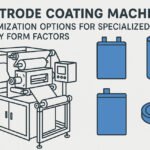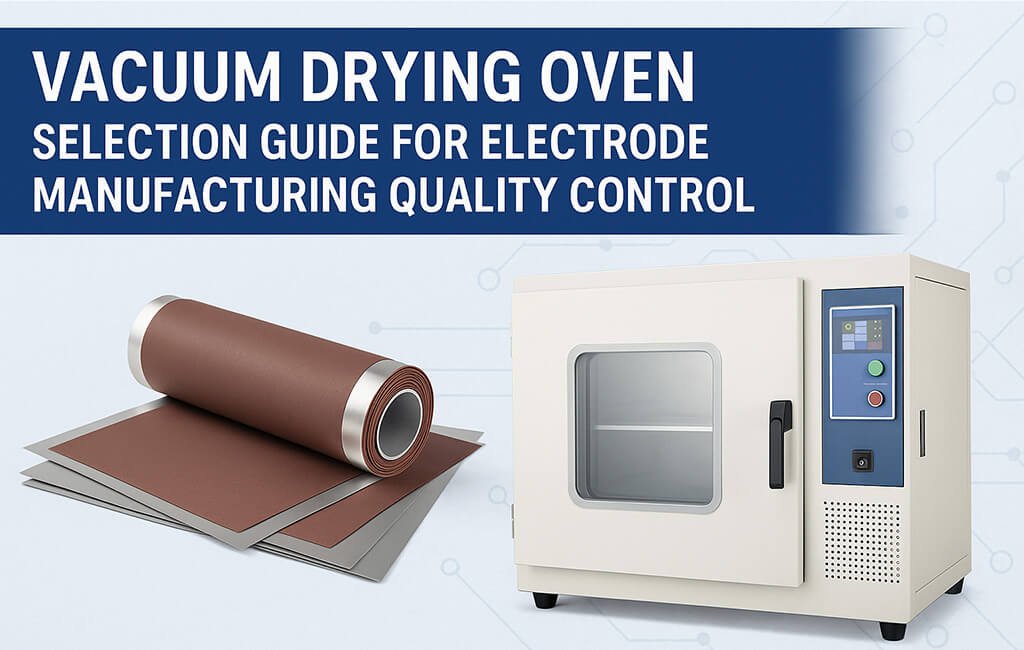In lithium-ion battery production, moisture control during electrode manufacturing determines cell performance, safety, and lifespan. A vacuum drying oven serves as the critical quality control checkpoint between coating and assembly. Here, residual NMP solvent and moisture content must meet stringent specifications—typically below 500 ppm for standard chemistries and under 300 ppm for high-nickel NMC formulations.
This engineering guide addresses the technical requirements, process parameters, and quality control integration specific to battery electrode drying. It fills the gaps left by generic laboratory equipment guides that dominate current search results.
What Makes Battery Electrode Drying Different from Standard Vacuum Applications?
Unlike pharmaceutical powders or electronic components, battery electrodes present unique drying challenges. Standard vacuum drying oven specifications fail to address these specific requirements.
Multi-Layer Composite Structure
Battery electrodes consist of complex layered materials. Each layer requires specific drying conditions to maintain integrity.
- Active material layer: 50-200 μm coating thickness containing NMC, NCA, LFP, or graphite particles
- Binder system: PVDF or water-based binders requiring specific temperature profiles to maintain adhesion
- Conductive additives: Carbon black networks that can degrade under excessive heat
- Current collector: Aluminum (cathode) or copper (anode) foil with thermal expansion considerations
Critical Process Windows
Electrode drying operates within narrow parameter ranges. Deviation from these windows causes defects and performance issues.
- Temperature: 80-120°C for NMP-based systems, 60-90°C for water-based
- Vacuum level: 10-50 Pa for efficient solvent removal without binder migration
- Heating rate: 1-3°C/min to prevent coating cracking or delamination
- Hold time: 4-12 hours depending on loading density and electrode thickness
How Do You Specify a Vacuum Drying Oven for Electrode Manufacturing?
When evaluating vacuum drying ovens for electrode production, specific features directly impact quality outcomes. Understanding these specifications helps prevent common manufacturing defects.
Temperature Uniformity Requirements
Battery electrodes demand exceptional temperature uniformity—typically ±2°C across the chamber. This precision prevents several critical failure modes:
- Differential drying rates: Leading to stress concentrations and cracking
- Binder migration: Causing adhesion failures during subsequent calendering
- Active material agglomeration: Reducing electrochemical performance
Leading equipment manufacturers like Despatch and Espec achieve this uniformity through multi-zone heating. They use independent PID control loops and forced convection systems designed for vacuum operation.
Vacuum System Design
The vacuum system must handle high solvent loads while maintaining precise pressure control. Each parameter directly affects electrode quality.
| Parameter | Specification | Impact on Electrode Quality |
|---|---|---|
| Ultimate vacuum | ≤10 Pa | Ensures complete NMP removal |
| Pumping speed | ≥50 m³/h | Maintains vacuum during solvent evolution |
| Pressure control | ±5 Pa | Prevents rapid boiling and coating damage |
| Solvent recovery | Cold trap at -40°C | Captures NMP for recycling/disposal |
Chamber Configuration for Production Scale
Production vacuum ovens differ significantly from laboratory units. They require specialized features for high-volume manufacturing.
- Horizontal shelf design: Accommodates electrode sheets up to 600mm width
- Multi-tier loading: 10-20 shelves with 50-100mm spacing
- Roll-to-roll capability: Pass-through designs for continuous web processing
- Inert gas backfill: Nitrogen purge prevents oxidation during cool-down
What Competitors Missed: Battery-Specific Quality Control Integration
Generic vacuum oven guides overlook critical quality control measurements required for electrode manufacturing. Modern systems integrate advanced monitoring capabilities.
In-Line Moisture Measurement
Real-time moisture monitoring ensures consistent product quality. These systems provide immediate feedback for process adjustments.
- Karl Fischer coulometry: Automated sampling ports for moisture verification
- NIR spectroscopy: Non-destructive monitoring through view ports
- Dew point sensors: Chamber atmosphere monitoring for process control
Data Logging and Traceability
Automotive battery production requires comprehensive documentation. Every parameter must be tracked and verified.
- 21 CFR Part 11 compliance: Electronic signatures and audit trails
- Batch records: Temperature, pressure, and time profiles for each lot
- SPC integration: Real-time process capability monitoring
- MES connectivity: Integration with factory execution systems
Common Electrode Drying Defects and Prevention Strategies
Unlike standard applications, electrode drying presents specific failure modes. Understanding these defects helps optimize process parameters.
Coating Cracking
Cause: Rapid solvent removal creating internal stresses
Prevention: Implement controlled drying protocols to minimize stress formation.
- Implement staged vacuum ramping: atmospheric → 500 Pa → 50 Pa → 10 Pa
- Limit heating rate to 2°C/min during initial solvent evolution
- Maintain electrode temperature below glass transition of binder (85°C for PVDF)
Binder Migration
Cause: Capillary flow during slow drying
Prevention: Balance evaporation rates with material transport phenomena.
- Optimize vacuum level to balance evaporation rate with diffusion
- Use multi-zone heating to create controlled temperature gradients
- Pre-dry at 60°C/atmospheric pressure before vacuum application
Residual Solvent Pockets
Cause: Inadequate mass transfer in thick coatings
Prevention: Enhance mass transfer through optimized process conditions.
- Extend hold time based on coating thickness: 4 hours for 100 μm, 8 hours for 150 μm
- Implement vacuum cycling: alternate between 10 Pa and 100 Pa
- Increase shelf spacing for improved vapor evacuation
Process Parameter Optimization by Electrode Chemistry
Different active materials require tailored drying protocols. Each chemistry has unique thermal stability limits and moisture sensitivity.
High-Nickel NMC (811, 9055)
High-nickel cathodes demand careful temperature control. Surface degradation occurs rapidly above critical temperatures.
- Temperature: 100-110°C maximum to prevent lithium carbonate formation
- Atmosphere: <100 ppm O₂ during cooling to minimize surface degradation
- Moisture target: <300 ppm for optimal cycle life
- Special consideration: Pre-heat shelves before loading to minimize exposure time
LFP (Lithium Iron Phosphate)
LFP materials offer greater thermal stability. This allows more aggressive drying parameters.
- Temperature: 120-130°C acceptable due to thermal stability
- Vacuum level: 20-30 Pa sufficient for water-based binders
- Moisture target: <500 ppm acceptable
- Cycle time: 30% faster than NMC due to higher temperature tolerance
Silicon-Graphite Anodes
Silicon-containing anodes require gentle processing. Volume changes during drying can cause mechanical failure.
- Temperature: 80-90°C to prevent SEI precursor decomposition
- Vacuum ramping: Extra gradual to accommodate expansion
- Moisture target: <200 ppm critical for first cycle efficiency
- Loading density: Reduced by 40% to allow for volume changes
Equipment Selection Framework: Laboratory vs. Pilot vs. Production
Scaling from R&D to manufacturing requires different vacuum drying oven configurations. Each scale has distinct requirements and capabilities.
Laboratory Scale (50-200L)
Application: Material qualification, process development
Key features: Laboratory systems prioritize flexibility over throughput.
- Single-zone heating sufficient for small samples
- Manual loading with observation windows
- Basic PLC with recipe storage for 10-20 programs
- Example: Yamato ADP-512 or Thermo Scientific Lindberg/Blue M
Pilot Scale (500-1000L)
Application: Process validation, small-batch production
Key features: Pilot systems bridge laboratory and production requirements.
- Multi-zone heating with ±1.5°C uniformity
- Automated loading systems for 50-100 kg batches
- Advanced controls with data historian capabilities
- Example: Despatch TAD series or Gruenberg custom systems
Production Scale (2000L+)
Application: High-volume manufacturing
Key features: Production systems emphasize reliability and throughput.
- Continuous or semi-continuous operation
- Integration with coating and calendering lines
- Redundant vacuum systems for reliability
- Example: Eisenmann continuous vacuum dryers or Hitachi roll-to-roll systems
Comparative Analysis: Vacuum Drying vs. Alternative Technologies
While competitors focus solely on vacuum ovens, electrode manufacturers must evaluate alternatives. Each technology offers distinct advantages for specific applications.
| Technology | Moisture Capability | Cycle Time | Energy Consumption | Suitable Applications |
|---|---|---|---|---|
| Vacuum Drying | <300 ppm | 6-12 hours | High | All chemistries, thick coatings |
| Atmospheric IR | <1000 ppm | 10-30 minutes | Medium | Thin coatings, initial drying |
| Microwave Vacuum | <200 ppm | 2-4 hours | Medium | R&D, specialty materials |
| Freeze Drying | <100 ppm | 24-48 hours | Very High | Solid-state electrodes |
Maintenance and Validation Requirements
Battery manufacturers require rigorous equipment qualification. Each phase ensures consistent, reliable operation.
Installation Qualification (IQ)
Initial verification confirms proper installation and safety systems. All critical parameters must meet specifications.
- Vacuum integrity testing: <0.1 Pa/min leak rate
- Temperature mapping: 27-point study per shelf
- Safety system verification: Over-temperature, vacuum relief, emergency stop
- Utilities confirmation: Power quality, compressed air, cooling water
Operational Qualification (OQ)
Performance testing validates equipment capabilities. Both empty and loaded conditions must be evaluated.
- Empty chamber uniformity: ±2°C at 80°C, 100°C, 120°C
- Loaded chamber performance: Using dummy loads matching electrode mass
- Vacuum pump down curves: Time to reach 10 Pa, 50 Pa, 100 Pa
- Recipe repeatability: 3 consecutive identical cycles
Performance Qualification (PQ)
Product-specific testing confirms process outcomes. Actual electrodes verify moisture removal and quality.
- Product moisture testing: Karl Fischer on actual electrodes
- Adhesion verification: 180° peel testing post-drying
- Throughput validation: kg/hour at specification
- Energy consumption baseline: kWh/kg dried electrode
Troubleshooting Guide: Common Vacuum Drying Oven Issues
Real-world problems require systematic diagnostic approaches. These issues are absent from generic equipment guides.
Problem: Inconsistent Moisture Levels Across Batch
Diagnostic approach: Systematic investigation identifies root causes.
- Map moisture content by shelf position using grid sampling
- Verify temperature uniformity with independent thermocouples
- Check vacuum gauge calibration and pump performance
- Inspect door seals and feedthrough integrity
Typical root causes: Most issues stem from equipment degradation or improper loading.
- Blocked vapor paths from overloading
- Degraded pump oil reducing ultimate vacuum
- Shelf warping causing poor thermal contact
Problem: Extended Cycle Times
Investigation sequence: Compare current performance against baseline data.
- Trend pump-down curves against baseline
- Monitor chamber pressure during solvent evolution
- Verify cold trap efficiency and capacity
- Analyze heating rate achievement vs. setpoint
Common solutions: Address vacuum system performance and loading configurations.
- Increase pump capacity or add booster pump
- Optimize loading configuration for vapor flow
- Implement predictive pump maintenance
Conclusion: Elevating Electrode Quality Through Precision Vacuum Drying
Selecting a vacuum drying oven for electrode manufacturing extends far beyond generic laboratory equipment specifications. Success requires understanding the intricate relationships between drying parameters, electrode chemistry, and final cell performance. By focusing on battery-specific requirements—from NMP removal kinetics to moisture measurement integration—manufacturers can achieve the sub-500 ppm moisture levels critical for automotive-grade lithium-ion batteries.
The transition from laboratory to production scale demands careful consideration of throughput, uniformity, and process control capabilities. As electrode designs evolve toward thicker coatings and novel chemistries, vacuum drying technology must adapt. Equipment selection today must maintain the precision required for consistent, high-quality battery production tomorrow.



